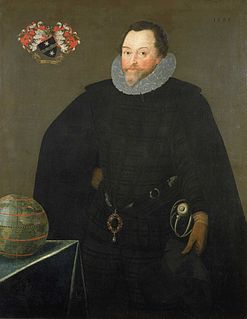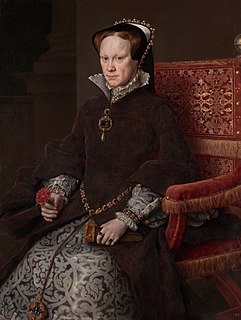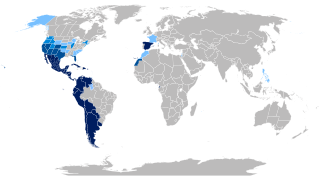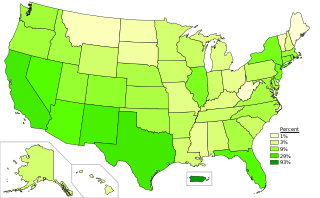
Elizabeth I was Queen of England and Ireland from 17 November 1558 until her death in 1603. Sometimes referred to as the Virgin Queen, Elizabeth was the last of the five monarchs of the House of Tudor.

Sir Francis Drake was an English explorer, sea captain, privateer, slave trader, naval officer, and politician. Drake is best known for his circumnavigation of the world in a single expedition, from 1577 to 1580. This included his incursion into the Pacific Ocean, until then an area of exclusive Spanish interest, and his claim to New Albion for England, an area in what is now the U.S. state of California. His expedition inaugurated an era of conflict with the Spanish on the western coast of the Americas, an area that had previously been largely unexplored by Western shipping.

H, or h, is the eighth letter in the ISO basic Latin alphabet. Its name in English is aitch, or regionally haitch.

Mary I, also known as Mary Tudor, and as "Bloody Mary" by her Protestant opponents, was Queen of England and Ireland from July 1553 until her death in 1558. She is best known for her vigorous attempt to reverse the English Reformation, which had begun during the reign of her father, Henry VIII. Her attempt to restore to the Church the property confiscated in the previous two reigns was largely thwarted by Parliament, but during her five-year reign, Mary had over 280 religious dissenters burned at the stake in the Marian persecutions.

North America is a continent in the Northern Hemisphere and almost entirely within the Western Hemisphere. It is bordered to the north by the Arctic Ocean, to the east by the Atlantic Ocean, to the southeast by South America and the Caribbean Sea, and to the west and south by the Pacific Ocean. Because it is on the North American Tectonic Plate, Greenland is included as a part of North America geographically.

Spanish is a Romance language of the Indo-European language family that evolved from colloquial Latin spoken in the Iberian Peninsula of Europe. Today, it is a global language with more than 500 million native speakers, mainly in the Americas and Spain. Spanish is the official language of 20 countries. It is the world's second-most spoken native language after Mandarin Chinese; the world's fourth-most spoken language overall after English, Mandarin Chinese, and Hindustani (Hindi-Urdu); and the world's most widely spoken Romance language. The largest population of native speakers is in Mexico.

Tagalog is an Austronesian language spoken as a first language by the ethnic Tagalog people, who make up a quarter of the population of the Philippines, and as a second language by the majority. Its standardized form, officially named Filipino, is the national language of the Philippines, and is one of two official languages, alongside English.

Philip II, also known as Philip the Prudent, was King of Spain from 1556, King of Portugal from 1580, and King of Naples and Sicily from 1554 until his death in 1598. He was also jure uxoris King of England and Ireland from his marriage to Queen Mary I in 1554 until her death in 1558. He was also Duke of Milan from 1540. From 1555, he was Lord of the Seventeen Provinces of the Netherlands.

The United States does not have an official language at the federal level, but the most commonly used language is English, which is the de facto national language. It is also the only language spoken at home by the great majority of the U.S. population. Many other languages are also spoken at home, especially Spanish, according to the American Community Survey (ACS) of the U.S. Census Bureau; these include indigenous languages and languages brought to the U.S. by people from Europe, Africa, and Asia. However, the majority of speakers of these languages are bilingual and also speak English. Although 21.5% of U.S. residents report that they speak a language other than English at home, only 8.2% speak English less than "very well." Several other languages, notably creoles and sign languages, have developed in the United States. Approximately 430 languages are spoken or signed by the population, of which 177 are indigenous to the area. At least fifty-two languages formerly spoken in the country's territory are now extinct.

Spanish is the second most spoken language in the United States. There are over 41 million people aged five or older who speak Spanish at home, and the United States has the second largest Spanish-speaking population in the world, ahead of Spain. Spanish is also the most learned language other than English, with about six million students. Estimates range from 41 million to over 50 million native speakers, heritage language speakers, and second-language speakers. About half of all United States Spanish speakers also assessed themselves as speaking English "very well" in the 2000 US Census. That increased to 57% in the 2013–2017 American Community Survey. There is an Academy of the Spanish Language located in the United States as well.

Filipino, is an Austronesian language. It is the national language of the Philippines, and one of the two official languages of the country, with English. It is a standardized variety of Tagalog based on the native dialect, spoken and written, in Metro Manila, the National Capital Region, and in other urban centers of the archipelago. It is further enriched and developed by the other languages of the Philippines as mandated by the 1987 Constitution. Filipino is only used as a tertiary language in the Philippine public sphere.

Ñ, or ñ, is a letter of the modern Latin alphabet, formed by placing a tilde on top of an upper- or lower-case N. It became part of the Spanish alphabet in the eighteenth century when it was first formally defined, but it has subsequently been used in other languages, such as Galician, Asturian, the Aragonese Grafía de Uesca, Basque, Chavacano, some Philippine languages, Chamorro, Guarani, Quechua, Mapudungun, Mandinka, Papiamento, and Tetum alphabets, as well as in Latin transliteration of Tocharian and many Indian languages, where it represents or. It represents in Crimean Tatar, Kazakh, ALA-LC romanization for Turkic languages, the Common Turkic Alphabet, Nauruan and romanized Quenya. In Breton and in Rohingya, it denotes nasalization of the preceding vowel. Many Portuguese speakers use this letter in informal internet language to represent the word não (no).

James VI and I was King of Scotland as James VI from 24 July 1567 and King of England and Ireland as James I from the union of the Scottish and English crowns on 24 March 1603 until his death in 1625. The kingdoms of Scotland and England were individual sovereign states, with their own parliaments, judiciaries, and laws, though both were ruled by James in personal union.

There are some 120 to 187 languages spoken in the Philippines, depending on the method of classification. Almost all are Malayo-Polynesian languages native to the archipelago. A number of Spanish-influenced creole varieties generally called Chavacano are also spoken in certain communities. The 1987 constitution designates Filipino, a standardized version of Tagalog, as the national language and an official language along with English. Filipino is regulated by Komisyon sa Wikang Filipino and serves as a lingua franca used by Filipinos of various ethnolinguistic backgrounds.

A garrote or garrote vil is a weapon, usually a handheld ligature of chain, rope, scarf, wire or fishing line, used to strangle a person.

The Anglo-Spanish War (1585–1604) was an intermittent conflict between the Habsburg Kingdom of Spain and the Kingdom of England. It was never formally declared. The war included much English privateering against Spanish ships, and several widely separated battles. It began with England's military expedition in 1585 to what was then the Spanish Netherlands under the command of the Earl of Leicester, in support of the Dutch rebellion against Spanish Habsburg rule.
GOL TV is an American TV sports channel dedicated to soccer owned by GOLTV Inc., based in North Bay Village, Florida. The network broadcasts Portugal Primeira Liga, Paraguayan Primera División, Uruguayan Primera División, and Ecuadorian Serie A matches.

Google Translate is a multilingual neural machine translation service developed by Google to translate text, documents and websites from one language into another. It offers a website interface, a mobile app for Android and iOS, and an API that helps developers build browser extensions and software applications. As of October 2022, Google Translate supports 133 languages at various levels, and as of April 2016, claimed over 500 million total users, with more than 100 billion words translated daily, after the company stated in May 2013 that it served over 200 million people daily.

The Spanish Armada was a Spanish fleet of 130 ships that sailed from Lisbon in late May 1588 under the command of the Duke of Medina Sidonia, with the purpose of escorting an army from Flanders to invade England. Medina Sidonia was an aristocrat without naval command experience but was made commander by King Philip II. The aim was to overthrow Queen Elizabeth I and her establishment of Protestantism in England, to stop English interference in the Dutch Revolt, and to stop the harm caused by English and Dutch privateering ships that disrupted Spanish interests in the Americas.

Telemundo is an American Spanish-language terrestrial television network owned by NBCUniversal Telemundo Enterprises, a division of NBCUniversal, which in turn is owned by Comcast. It provides content nationally with programming syndicated worldwide to more than 100 countries in over 35 languages.




















